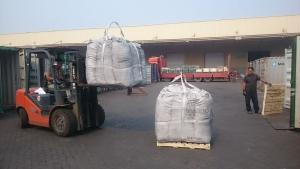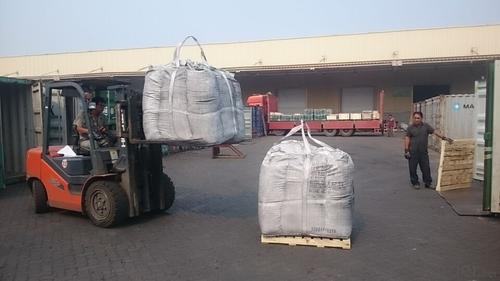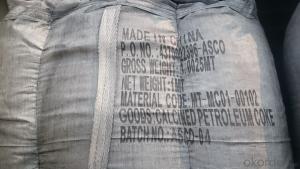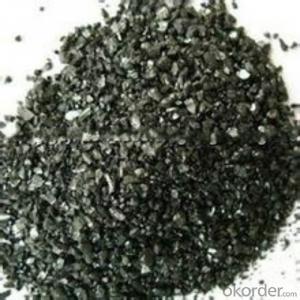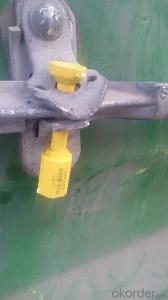GPC with lower Sulphur0.03% max in 1-5mm
- Loading Port:
- Tianjin
- Payment Terms:
- TT OR LC
- Min Order Qty:
- 20 m.t.
- Supply Capability:
- 5000 m.t./month
OKorder Service Pledge
OKorder Financial Service
You Might Also Like
Introduction:
GPC has good characteristics with low ash, low resistivity, low sulphur, high carbon and high density. It is the best material for high quality carbon products. It is used as carbon additive in steel industry or fuel.
Features:
1.Our strong team provide you reliable service that make you feel purchasing is more easier
2. We ensure that we can supply capability with competitive price.
3. Work strictly to guarantee product quality,
4. Highest standard of integrity. Guarantee customer's benefit.
5. Supplying Pet Coke, Met coke, Foundry Coke, Carbon Raiser etc.
Specifications:
F.C.% | 95MIN | 94MIN | 93MIN | 92MIN | 90MIN | 85MIN | 84MIN |
ASH % | 4MAX | 5MAX | 6 MAX | 6.5MAX | 8.5MAX | 12MAX | 13MAX |
V.M.% | 1 MAX | 1MAX | 1.0MAX | 1.5MAX | 1.5MAX | 3 MAX | 3 MAX |
SULFUR % | 0.3MAX | 0.3MAX | 0.3MAX | 0.35MAX | 0.35MAX | 0.5MAX | 0.5MAX |
MOISTURE % | 0.5MAX | 0.5MAX | 0.5MAX | 0.5MAX | 0.5MAX | 1MAX | 1MAX |
Pictures

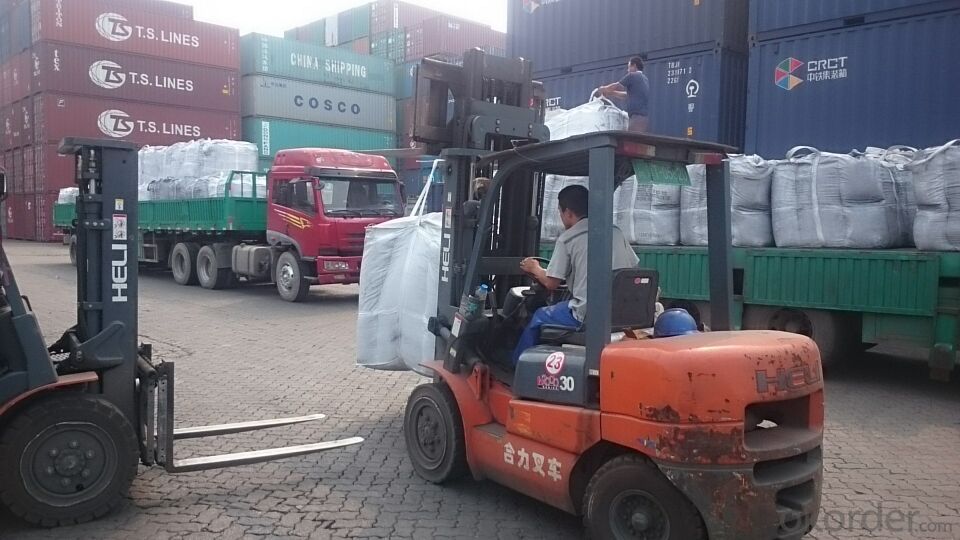
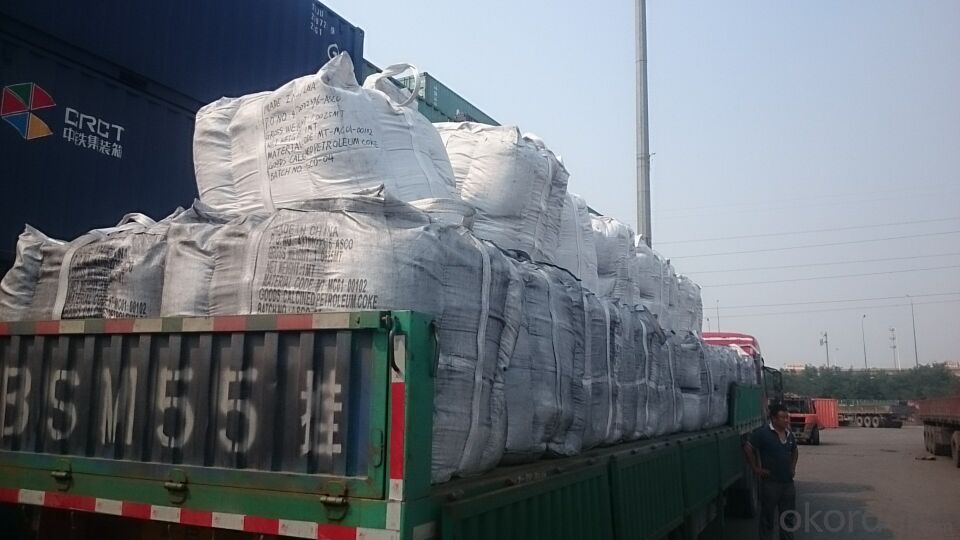
FAQ:
1. Your specification is not very suitable for us.
Please offer us specific indicators by TM or email. We will give you feedback as soon as possible.
2. When can I get the price?
We usually quote within 24 hours after getting your detailed requirements, like size, quantity etc. .
If it is an urgent order, you can call us directly.
3. Do you provide samples?
Yes, samples are available for you to check our quality.
Samples delivery time will be about 3-10 days.
4. What about the lead time for mass product?
The lead time is based on the quantity, about 7-15 days. For graphite product, apply Dual-use items license need about 15-20 working days.
5. What is your terms of delivery?
We accept FOB, CFR, CIF, EXW, etc. You can choose the most convenient way for you. Besides that,
we can also shipping by Air and Express.
6. Product packaging?
We are packed in bulk ship or in ton bag or placing in container or according to your requirements.
7. Notice
please note that the price on Alibaba is a rough price. The actual price will depends on raw materials, exchange rate wage and your order quantity .Hope to cooperation with you, thanks !
- Q: How does carbon affect water quality?
- Water quality can be affected both positively and negatively by carbon. On the positive side, carbon is a natural component of the carbon cycle and has a vital role in maintaining the equilibrium of aquatic ecosystems. It serves as a nutrient for aquatic plants, aiding their growth and providing nourishment and shelter for other organisms in the food chain. However, an excess of carbon in water can have adverse effects on water quality. One way this occurs is through the rise of dissolved organic carbon (DOC). Elevated levels of DOC can result from the decomposition of organic matter, such as deceased plants and animals, as well as the leaching of organic compounds from soil. These organic compounds can harm water quality by diminishing the amount of dissolved oxygen accessible to aquatic organisms, leading to asphyxiation of fish and other aquatic life. Moreover, high levels of carbon can contribute to eutrophication. Eutrophication takes place when there is an overflow of nutrients, including carbon, in water bodies, causing an excessive growth of algae and other aquatic plants. This excessive growth can deplete oxygen levels in the water as the plants decompose, causing harm to fish and other organisms that rely on oxygen for survival. Additionally, carbon can interact with other pollutants present in water, like heavy metals and pesticides, which can become more toxic and readily available when combined with carbon. This can have detrimental effects on aquatic organisms and disrupt the overall balance of the ecosystem. In conclusion, while carbon is vital for the functioning of aquatic ecosystems, excessive amounts can negatively impact water quality by reducing oxygen levels, promoting eutrophication, and increasing the toxicity of other pollutants. Therefore, it is crucial to monitor and manage carbon levels in water bodies to ensure the maintenance of a healthy and balanced aquatic ecosystem.
- Q: How is carbon used in the production of steel?
- The production of steel heavily relies on carbon as it directly impacts the characteristics and properties of the end product. Carbon is primarily used as an alloying element in the steelmaking process, where it is carefully added to modify the composition of the steel. The basic oxygen furnace (BOF) process is one of the most commonly employed methods for steel production. In this process, carbon is introduced to the molten iron to achieve the desired grade of steel. The quantity of carbon added determines the steel's mechanical properties, including hardness and strength. Generally, higher levels of carbon result in a harder and stronger steel. Another steelmaking process, known as the electric arc furnace (EAF) process, also utilizes carbon. In this process, recycled steel scrap is melted down using an electric arc to create new steel. Carbon is added during this stage to adjust the carbon content to meet the requirements of the desired steel grade. Moreover, carbon plays a critical role in the heat treatment of steel. Through techniques like carburizing and quenching, carbon is utilized to enhance the surface hardness and wear resistance of steel components. This is particularly vital in industries such as automotive, aerospace, and construction, where the durability and strength of steel are of utmost importance. To summarize, carbon is indispensable in the production of steel as it directly influences the mechanical properties and overall quality of the final product. From regulating the carbon content to controlling heat treatment processes, carbon serves as an essential component in the steelmaking industry.
- Q: What is the symbol for carbon?
- The symbol for carbon is C.
- Q: What is the thickness of carbon fiber heating?
- Tile floor pavement thickness generally in 4,5 cm, composite floor that cement cushion thickness is generally 3,4 cm, a Ji'nan to do this as if the thickness reach 3 cm, composite floor to reach 2 cm, also does not affect the results, suitable for thin layer height of the house now, is Ji'nan Dilong carbon fiber applied Technology Development Company
- Q: What are the different forms of carbon?
- The different forms of carbon include diamond, graphite, fullerenes, and carbon nanotubes.
- Q: What is the atomic number of carbon?
- The atomic number of carbon is 6.
- Q: What is carbon dioxide?
- Carbon dioxide (CO2) is a colorless and odorless gas that consists of carbon and oxygen atoms. It is formed through the combustion of fossil fuels, as well as the natural processes of respiration and volcanic activity. Carbon dioxide plays a crucial role in the Earth's atmosphere as a greenhouse gas, trapping heat and contributing to the planet's overall temperature. While it occurs naturally, human activities such as burning of fossil fuels and deforestation have significantly increased its concentration in the atmosphere, leading to global warming and climate change. Carbon dioxide is also a byproduct of various industrial processes, such as cement production and power generation. Efforts to reduce carbon dioxide emissions are essential to mitigate the effects of climate change and maintain a sustainable environment.
- Q: What is carbon black rubber?
- Carbon black rubber is a type of rubber that is reinforced with carbon black particles. Carbon black is a fine black powder made from the incomplete combustion of hydrocarbons. It is added to rubber formulations to enhance its strength, durability, and resistance to wear and tear. This type of rubber is commonly used in the manufacturing of tires, conveyor belts, seals, gaskets, and various other rubber products.
- Q: What is carbon fiber and how is it used?
- Carbon fiber is a lightweight and incredibly strong material that is made from thin strands of carbon atoms bonded together in a specific pattern. It is known for its exceptional strength-to-weight ratio, making it significantly stronger than steel while being much lighter in weight. Carbon fiber is used in a wide range of industries and applications due to its unique properties. In the aerospace industry, it is commonly used to build aircraft components such as wings, fuselage sections, and engine parts. Its high strength and low weight help increase fuel efficiency and enhance overall performance. The automotive industry also extensively utilizes carbon fiber in the production of high-performance vehicles. Carbon fiber reinforced composites are used to manufacture various parts, including body panels, chassis components, and interior trims. The use of carbon fiber in automobiles not only reduces the overall weight of the vehicle, but also improves its structural integrity and enhances handling and fuel efficiency. Sports equipment manufacturers incorporate carbon fiber in the production of sporting goods such as tennis rackets, golf clubs, bicycles, and hockey sticks. The material's strength and stiffness allow for enhanced performance, increased power transfer, and improved durability. In addition, carbon fiber finds applications in the construction industry for reinforcing concrete structures, as well as in the manufacturing of wind turbine blades, boat hulls, and various other industrial components. Overall, carbon fiber's exceptional strength, lightweight nature, and versatility make it a preferred choice in industries where high-performance materials are required. Its use continues to expand as advancements in manufacturing techniques and cost reduction efforts make it more accessible to a wider range of applications.
- Q: What about my world carbon board?
- First put the coal into the crusher and crush it into carbon powder (some versions are pulverized coal), so that they can be synthesizedCarbon powder, carbon fiberToner carbon powderCarbon fiber = carbon mesh (as if by name)Carbon fiber n.Put the carbon mesh into the compressor and compress the carbon plate
Send your message to us
GPC with lower Sulphur0.03% max in 1-5mm
- Loading Port:
- Tianjin
- Payment Terms:
- TT OR LC
- Min Order Qty:
- 20 m.t.
- Supply Capability:
- 5000 m.t./month
OKorder Service Pledge
OKorder Financial Service
Similar products
Hot products
Hot Searches
